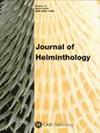利用 Duddingtonia flagrans(一种线虫诱捕真菌)对立陶宛牧场犊牛的三代线虫感染进行生物防治
IF 1.3
3区 生物学
Q4 PARASITOLOGY
引用次数: 0
摘要
立陶宛研究了用两种剂量水平的线虫诱捕真菌 Duddingtonia flagrans 喂养首次放牧的小牛对牧草中感染性三代线虫幼虫污染水平的影响。30 头 3-6 个月大的小母牛被分为 A、B 和 C 三组,每组在 1.07 公顷的围场(a、b 和 c)上放牧。这些围场自然沾染了前一年放牧的受感染牛身上的三尾线虫幼虫。从出栏后 3 周开始的两个月内,每天给动物喂食真菌材料。A 组和 B 组每天每公斤活重分别饲喂 106 个和 2.5×105 个衣壳孢子,C 组为不给药对照组。每两周对母牛进行一次称重和临床检查。在同一天采集粪便、血液和草样。从七月中旬开始,c 围场草样中感染性幼虫的数量明显增加(P<0.05),而真菌处理组放牧的 a 和 b 围场中感染性幼虫的数量较低。然而,结果表明,以每天每公斤活重 2.5×105 衣孢子的剂量施用真菌孢子并不能显著防止犊牛寄生,这可能是由于对粪便中发育中的感染性幼虫抑制不足。相比之下,每公斤 106 个衣壳孢子的剂量可降低牧草上的寄生虫幼虫数量,降低胃蛋白酶原水平(P<0.05),并防止犊牛发生寄生虫病。本文章由计算机程序翻译,如有差异,请以英文原文为准。
Biological control of trichostrongylid infections in calves on pasture in Lithuania using Duddingtonia flagrans a nematode-trapping fungus
The effect on the pasture contamination level with infective trichostrongylid larvae by feeding the nematode-trapping fungus, Duddingtonia flagrans at two dose levels to first time grazing calves was examined in Lithuania. Thirty heifer-calves, aged 3–6 months, were divided into three comparable groups, A, B and C. Each group was turned out on a 1.07 ha paddock (a, b and c). The paddocks were naturally contaminated with infective trichostrongylid larvae from infected cattle grazing the previous year. Fungal material was fed to the animals daily during a two month period starting 3 weeks after turnout. Groups A and B were given 106 and 2.5×105 chlamydospores per kg of live weight per day, respectively, while group C served as a non-dosed control group. Every two weeks the heifers were weighed and clinically inspected. On the same dates, faeces, blood and grass samples were collected. From mid-July onwards, the number of infective larvae in grass samples increased markedly (P<0.05) on paddock c, whereas low numbers of infective larvae were observed on paddocks a and b grazed by the fungus treated groups. However, the results indicate that administering fungal spores at a dose of 2.5×105 chlamydospores per kg live weight per day did not significantly prevent parasitism in calves, presumably due to insufficient suppression of developing infective larvae in the faeces. In contrast, a dose of 106 chlamydospores per kg lowered the parasite larval population on the pasture, reduced pepsinogen levels (P<0.05), and prevented calves from developing parasitosis.
求助全文
通过发布文献求助,成功后即可免费获取论文全文。
去求助
来源期刊

Journal of Helminthology
生物-动物学
CiteScore
2.80
自引率
12.50%
发文量
127
审稿时长
3 months
期刊介绍:
Journal of Helminthology publishes original papers and review articles on all aspects of pure and applied helminthology, particularly those helminth parasites of environmental health, medical or veterinary importance. Research papers on helminths in wildlife hosts, including plant and insect parasites, are also published along with taxonomic papers contributing to the systematics of a group. The journal will be of interest to academics and researchers involved in the fields of human and veterinary parasitology, public health, microbiology, ecology and biochemistry.
 求助内容:
求助内容: 应助结果提醒方式:
应助结果提醒方式:


